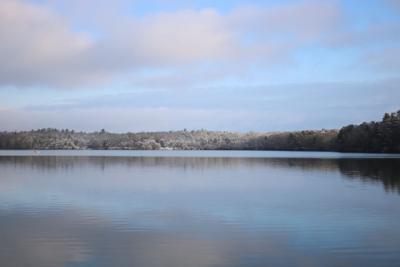‘Green Yard, Green Pond’ Selectmen Stress Reducing Fertilizer To Aid Santuit Pond
By RYAN SPENCER Aug 14, 2020

Mashpee selectmen are concerned about the impact of lawn fertilizers on the health of Santuit Pond.
FILE PHOTOGRAPH BY RYAN SPENCER/ENTERPRISE
The Mashpee Board of Selectmen might send residents educational materials asking them to aid in efforts to minimize nutrient pollution by reducing the amount of fertilizer applied to lawns.
The suggestion came on Monday, August 10, as the selectmen discussed efforts to remediate the scourge of cyanobacteria that has closed the pond to swimming for the fourth consecutive summer.
Health advisories went up at the pond in late July after town staff spotted a layer of the potentially toxic blue-green algae known as cyanobacteria while inspecting the adjacent Chop Chaque bog, which the town intends to purchase.
The health advisory warns against swimming or making contact with the water. The toxins some varieties of the algae produce have been known to kill pets and can cause a host of complications in humans, including liver damage.
“We seem to have this problem every year and it’s getting worse,” Selectwoman Carol A. Sherman said.
Selectman Andrew R. Gottlieb, who is also the executive director of the Association to Preserve Cape Cod, an environmental nonprofit with a cyanobacteria monitoring program, noted that toxic algae is an increasing problem throughout Cape Cod.
“My organization, we test 35 lakes in nine of the 15 towns on the Cape; [and] we found sufficiently high cyanobacteria in seven ponds now that has resulted in restrictions in use closures in five towns,” he said.
Mr. Gottlieb said Mashpee has three sources of the excess of phosphorus that accumulates in the river and fuels the algae blooms.
“It’s a septic system problem, and it is an over-fertilization problem, and it’s a road runoff problem,” he said, adding that even septic systems that function properly and have not failed contribute to the phosphorus. He noted that the long-term solution is sewering the developed areas around the pond.
The town has considered sewering the area near Santuit Pond as part of its comprehensive plan to address nitrogen pollution, but it would remain years down the line in the third phase of the five-phase plan. The town remains in the earliest stages of the first phase, which calls for sewering the Mashpee River watershed.
“We’ve got to get serious at some point about sewering these ponds and getting people right now today to lay off the fertilizers and go back to more native species planting,” Mr. Gottlieb said. “I don’t know what the fascination is about putting green lawns, but you’re killing your ponds.”
The continuous fertilization of lawns adds to waterways additional nutrients such as phosphorus, which contributes to the problem at Santuit Pond, and nitrogen, which contributes to the pollution impacting the town’s bays and estuaries, Mr. Gottlieb said.
The use of nonnative species means lawns have to be fertilized and watered on a regular basis, since the plans have not adapted to the Cape Cod climate and the region’s sandy soils, he said.
“We’re asking people to change their property management practices in a way that is less impactful to the pond. You’ve got to be willing to let some part of your yard go brown, and if you’re not: green yard, green pond,” he said.
Town Manager Rodney C. Collins noted that Mashpee has a bylaw regarding fertilizers already on the books. He asked whether Mr. Gottlieb believed the bylaw was being enforced.
“I think the current bylaw doesn’t make a hell of a lot of difference; the current bylaw simply says don’t fertilize when things aren’t growing, so don’t put all this fertilizer on the ground when there is no uptake by the plants,” Mr. Gottlieb said.
“So it’s inadequate?” Mr. Collins said.
“Grossly inadequate,” Mr. Gottlieb said. “But at the same time, in the same breath, towns have been preempted by the state from local regulation of fertilizer application. What remains legal is sufficient to continue to choke our ponds to death.”
Board Chairman John J. Cotton recommended that an informational letter be drafted to be sent to residents within a 300-foot circumference of the pond.
“It just starts with information. I’m one of those within 300 feet [of the pond]. I would be happy to see a letter saying what is good and what is bad to put on my lawn. We’ll bring this back up at the next meeting, see how that goes,” he said.
